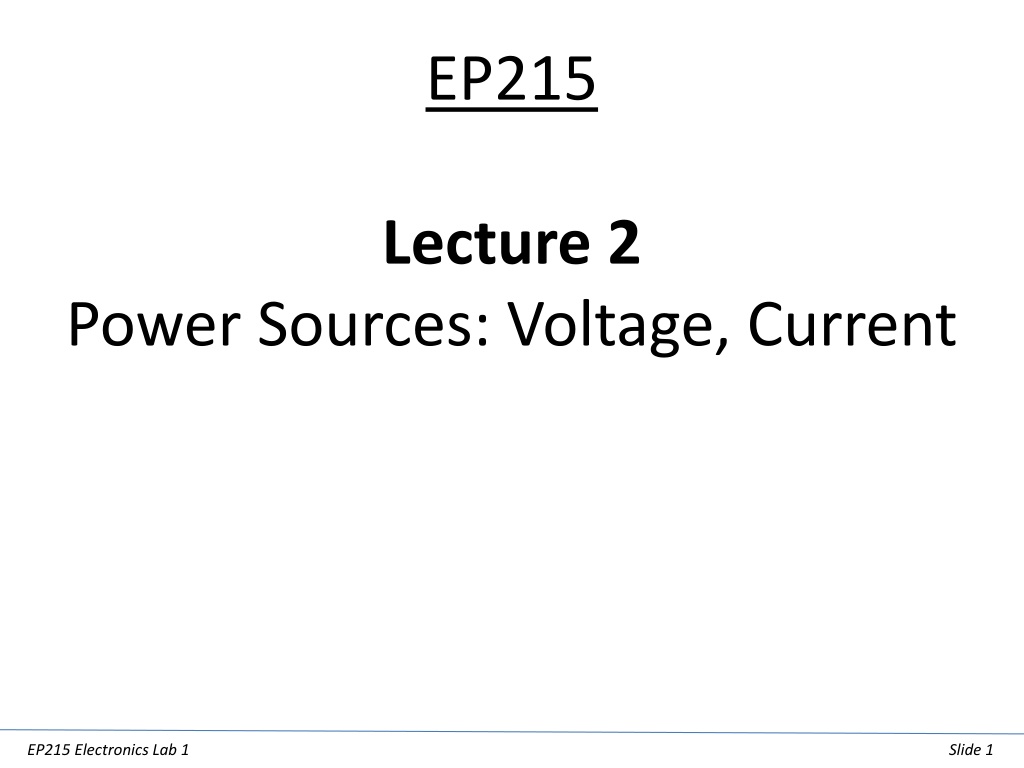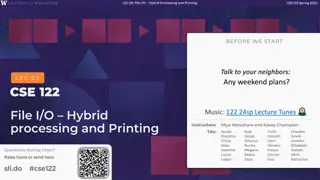
Understanding Power Sources in Electronics Labs
Explore the concept of voltage and current sources in electronics labs through benchtop power supplies and function generators. Learn how to convert a voltage source into a current source for different applications. Gain insights into load resistance and its impact on source characteristics.
Download Presentation

Please find below an Image/Link to download the presentation.
The content on the website is provided AS IS for your information and personal use only. It may not be sold, licensed, or shared on other websites without obtaining consent from the author. If you encounter any issues during the download, it is possible that the publisher has removed the file from their server.
You are allowed to download the files provided on this website for personal or commercial use, subject to the condition that they are used lawfully. All files are the property of their respective owners.
The content on the website is provided AS IS for your information and personal use only. It may not be sold, licensed, or shared on other websites without obtaining consent from the author.
E N D
Presentation Transcript
EP215 Lecture 2 Power Sources: Voltage, Current EP215 Electronics Lab 1 Slide 1
Review of Lab 1 (A) Benchtop power supply : DC power CV CC DT 5V +V0-V +V 0 5V 0 CV mode : Adjust +V w.r.t 0 CC mode : Set +V, adjust current Fixed 5V,0 Useful for Digital ckts Dual Tracking: One knob sets |V| EP215 Electronics Lab 1 Slide 2
We used bench PS in CV mode Set Voltage output to value Vset As the load RL = R1 + R2changes, the voltage across R1, R2 each change based on resistor voltage divider: ?2 ?1+ ?2 ???? ??2= ???? ?? Current also changes based on Ohm s law: ? = For any load RL and any current, the source supplies constant voltage Vset: Voltage Source EP215 Electronics Lab 1 Slide 3
Is the Function Generator a Voltage or Current Source? Really, it s a voltage source (of AC voltage). Notice the 50 output resistance label! We demonstrated how to make it act like a current source FG 50 Follows definition of a voltage source: Small internal R in series EP215 Electronics Lab 1 Slide 4
How to convert a Voltage source into a current source? First guess: current source has a Large internal resistance in parallel So how about adding 100 k in parallel ? FG FG 50 Doesn t work because load Still sees ~ 50 100k 100k 50 50||100k ~ 50 EP215 Electronics Lab 1 Slide 5
How to convert a Voltage source into a current source? Second guess: Add 100 k in series ? FG FG 100k 100k Works Load sees 50 k (Note that just adding the 100 k series would also work!) 50 100k 100k 50 100k||100k =50k EP215 Electronics Lab 1 Slide 6
How good is our current source? Current Source: Large internal resistance in parallel FG 50k Works RL only if RL << 50 k EP215 Electronics Lab 1 Slide 7
RL is important in determining source characteristics Current Source: Large internal resistance in parallel FG 50k Works If RL becomes large, say RL=50 k , Current will be split in half between internal 50 k and RL EP215 Electronics Lab 1 Slide 8
Source behavior is dependent on RL In general, a voltage source likes a large RL In general, a current source likes a small RL EP215 Electronics Lab 1 Slide 9



![Lec [2] Health promotion](/thumb/274962/lec-2-health-promotion-powerpoint-ppt-presentation.jpg)